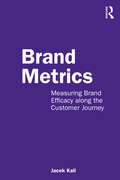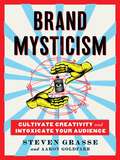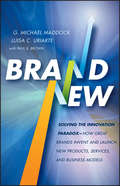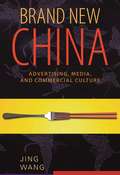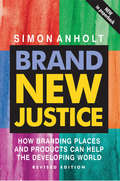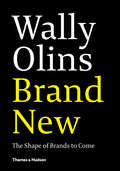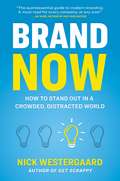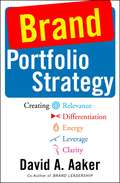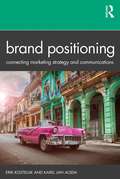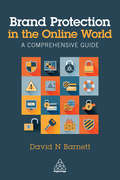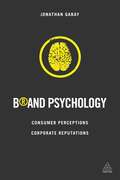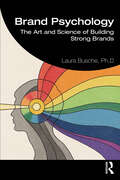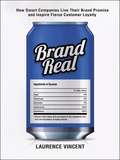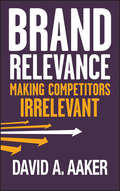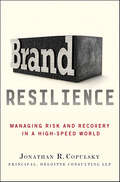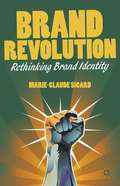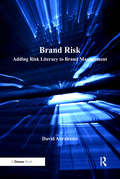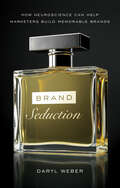- Table View
- List View
Brand Metrics: Measuring Brand Efficacy along the Customer Journey
by Jacek KallThis book gathers and explains the key brand analysis tools that measure brand effectiveness and awareness along the customer journey. Rather than considering how to build and manage a brand, Brand Metrics shows students the methods by which they can assess the current market position of the brand and design effective strategies for the future. Each chapter follows the same logical and accessible structure, defining each metric and its usage, presenting the calculations, showing how the data should be interpreted, offering case studies and examples, presenting recommendations and offering questions for further discussion. The metrics covered in the book correspond with the customer journey, moving through measuring brand awareness, consideration and purchase, to customer loyalty and brand advocacy, and finally an overall analysis of the brand’s strength. The book not only shows the formula for a metric and explains how it should be interpreted, but also considers what each metric really measures, how it impacts the brand’s equity and how it is related to other metrics. As such it should be perfect recommended reading for advanced undergraduate and postgraduate students of Strategic Brand Management, Marketing Planning and Strategy, Marketing and Branding Metrics.
Brand Mysticism: Cultivate Creativity and Intoxicate Your Audience
by Steven Grasse Aaron GoldfarbAn irreverent and wide-ranging treatise on building and maintaining a standout brand in business or in life, from the marketing mastermind behind countless iconic booze labels. Steven Grasse made a name for himself as not only a distiller but also the mind behind beloved brands like Hendrick&’s Gin and Sailor Jerry Rum and the guy who made cheap-beer-standbys like Narragansett and Miller High Life cool again. Through his work in advertising and marketing, Grasse has changed the game in the booze world and become an authority on building an authentic, enduring, and deeply beloved brand. Food & Wine has called him &“the punk-rock prince of small-batch spirits.&” So how did he do it? Through practicing brand mysticism, a mentality for all endeavors based on keeping an open mind, taking risks, and developing authenticity—skills that have benefited him in booze, business, and beyond. In this book, he&’s sharing this practice with the world. Through lessons (big life things that feel like just cool stories), case studies (how did Sailor Jerry become the punk rock Captain Morgan?), and magical ingredients (what makes a great message sing), Brand Mysticism guides you through the steps it takes to channel entrepreneurial spirit into a brand, a business, a creative practice, or a life that breaks with tradition to achieve the remarkable.
Brand Names and Product Dynasties: Lessons in Retrospect
by Barrie Blake ColemanIn the context of modern branding, product packaging, characterisation, promotion and marketing, it comes as no surprise that it has all been done before! Branding, and branding strategies have hitherto gained a reputation as a black art. Collective experience and past episodes underscore the agony of indecision that surrounds the naming of a new product. Yet, curiously, history teaches that the choice of successful brand names owe more to intuition, misplaced belief and naivety than to meticulous strategic planning.
Brand New
by Paul B. Brown G. Michael Maddock Luisa C. Uriarte Javier Flaim Brett S. Miller Maddock DouglasBrand New's revolutionary innovation process is a proven road map you can put to work immediately to create successful new products, services, and business models. Written by leading innovation practitioners, and the coauthor of the bestseller Customers for Life, the authors of this tightly focused, highly entertaining book have nailed the issue perfectly when it comes to successfully introducing anything new. Research shows people like new products and services. Indeed they go out of their way to try to find them. Yet companies are truly terrible at providing new products and services that meet these customers' needs. Why are companies so bad at giving customers what they want? Because they lack a simple proven process that makes sure innovation occurs efficiently time after time. No one knows this better than Mike Maddock and his team at Maddock Douglas, the Agency of Innovation,™ which has worked closely with more than a quarter of Fortune 100. To solve the innovation paradox, Maddock explains the process his team has used to help the world's best companies and shows you how to Find needs and opportunity in the marketplace Come up with significant market insights Create compelling communication (using the actual words your customers use) to convince people to try your new creation What has worked for some of the world's most successful companies, when it comes to innovation, will work for you. Start putting the lessons of Brand New to work for you. . . before the competition does.
Brand New China: Advertising, Media, and Commercial Culture
by Jing WangOne part riveting account of fieldwork and one part rigorous academic study, Brand New China offers a unique perspective on the advertising and marketing culture of China. Jing Wang’s experiences in the disparate worlds of Beijing advertising agencies and the U.S. academy allow her to share a unique perspective on China during its accelerated reintegration into the global market system. Brand New China offers a detailed, penetrating, and up-to-date portrayal of branding and advertising in contemporary China. Wang takes us inside an advertising agency to show the influence of American branding theories and models. She also examines the impact of new media practices on Chinese advertising, deliberates on the convergence of grassroots creative culture and viral marketing strategies, samples successful advertising campaigns, provides practical insights about Chinese consumer segments, and offers methodological reflections on pop culture and advertising research. This book unveils a “brand new” China that is under the sway of the ideology of global partnership while struggling not to become a mirror image of the United States. Wang takes on the task of showing where Western thinking works in China, where it does not, and, perhaps most important, where it creates opportunities for cross-fertilization. Thanks to its combination of engaging vignettes from the advertising world and thorough research that contextualizes these vignettes, Brand New China will be of interest to industry participants, students of popular culture, and the general reading public interested in learning about a rapidly transforming Chinese society.
Brand New Justice
by Simon AnholtRecently vilified as the prime dynamic driving home the breach between poor and rich nations, here the branding process is rehabilitated as a potential saviour of the economically underprivileged.Brand New Justice, now in a revised paperback edition, systematically analyses the success stories of the Top Thirteen nations, demonstrating that their wealth is based on the 'last mile' of the commercial process: buying raw materials and manufacturing cheaply in third world countries, these countries realise their lucrative profits by adding value through finishing, packaging and marketing and then selling the branded product on to the end-user at a hugely inflated price. The use of sophisticated global media techniques alongside a range of creative marketing activities are the lynchpins of this process.Applying his observations on economic history and the development and impact of global marketing, Anholt presents a cogent plan for developing nations to benefit from globalization. So long the helpless victim of capitalist trading systems, he shows that they can cross the divide and graduate from supplier nation to producer nation. Branding native produce on a global scale, making a commercial virtue out of perceived authenticity and otherness and fully capitalising on the 'last mile' benefits are key to this graduation and fundamental to forging a new global economic balance.Anholt argues with a forceful logic, but also backs his hypothesis with enticing glimpses of this process actually beginning to take place. Examining activities in India, Thailand, Russia and Africa among others, he shows the risks, challenges and pressures inherent in 'turning the tide', but above all he demonstrates the very real possibility of enlightened capitalism working as a force for good in global terms.
Brand New: The Shape of Brands to Come
by Wally OlinsThe world's leading practitioner of branding predicts the future of companies' identities in an ever -changing marketing landscape What is the future for brands and branding? Does globalization mean that variety and individuality will be crushed out of existence by massive multinationals? Will everywhere and everything become similar, like the world of airports today? Or will there still be room for brands that thrive on being different? What about the impact of digital technology and increasing customer feedback through the internet and social media? What, in fact, do customers want? Today's businesses, in addition to thinking about price and authenticity, have to deal with corporate social responsibility. How does this affect the products and services we consume? How does it influence the way we feel about organizations? Are corporations here to maximize profits and grow, or to help society, or both? With the rapid rise of new markets in India, China, Brazil, and elsewhere, will new global brands emerge based around local cultural strengths and heritage? If so, what will this mean for the traditional dominance of brands based on Western cultural norms? Wally Olins's fascinating book looks at every aspect of the world of branding. With his customary flair and no-nonsense prose, he analyzes the problems facing today's organizations, criticizes corporate missteps, praises those companies who seem to be building and sustaining brands efficiently in our brave new world, and predicts the future of branding. No one interested in marketing, business, or contemporary culture will want to be without this book.
Brand Now: How to Stand Out in a Crowded, Distracted World
by Nick WestergaardCapture their attention-and keep it! With the rise of digital media, you'd think it would be easier than ever to be heard. Yet, most messages fail to cut through the clutter. Consumers are overwhelmed. Ads alone aren't effective. And you can't just churn out content and connect on every social network. To stand out today, you need to start with your brand. Brand Now uncovers the new rules of branding in our complex and chaotic world. Written by the author of Get Scrappy, the digital marketing bible for business, this latest book explains how to build brands that resonate both online and off. The book helps you: Create a brand with meaning * Reinforce it with the right touchpoints * Hone your brand's unique story * Share it through engaging content * Cultivate a sense of community * Craft a coherent experience * Stand out with simplicity and transparency The world may be growing louder, but with Brand Now's big ideas and practical toolbox, you can break through the noise-and win a place in the hearts and minds of your customers.
Brand Personality: How to Build a Unique Brand
by Mike MoserA well-defined brand personality can create an immediate point of differentiation in the marketplace. This chapter will show you how to determine the personality your brand is going to use to communicate its core values and core message.
Brand Planning for the Pharmaceutical Industry
by Janice MacLennanWritten by John Lidstone and Janice MacLennan, the second edition of Marketing Planning for the Pharmaceutical Industry became accepted as the bible for the industry. In this new companion book Janice MacLennan picks up two of the themes touched on in Marketing Planning - market segmentation and branding, and the inter-relationship between these two - and with this book makes them key topics for discussion. Brand Planning for the Pharmaceutical Industry begins by exploring what branding is and why it is of importance, particularly to the pharmaceutical sector. The book then goes on to show how branding can be integrated into the early stages of the commercialization process for new products, both in theory and in the 'real' world. The book provides a step-by-step guide to brand planning, using market segmentation as the starting point. The book is split into two parts, the first dealing comprehensively with brand planning for products yet to get to the market, with the second part applying the same process to products that are already on the market. Both parts are extremely pragmatic, full of pertinent examples and insights from the pharmaceutical industry, and are directly applicable to your own brand planning. Brand Planning for the Pharmaceutical Industry concludes by confronting the problems that organizations are likely to have in actually making brand planning an integral part of their work and presents strategies for dealing with them.
Brand Portfolio Strategy and Brand Architecture
by Jill AveryWhile companies choose to brand their products and services in many different ways, there are some central tenets that help define an optimal brand portfolio and associated brand architecture. Brand portfolio strategy involves the design, deployment, and management of multiple brands as a coordinated portfolio of meaning-based assets that address the needs of diverse customers in a marketplace and maximize return while minimizing risk. It specifies the optimal portfolio of brands a company should maintain for comprehensive market coverage with minimal overlap, determines the role and scope of each brand in the portfolio, and designs a strategic, logical, and efficient brand architecture that knits the brands together into an interdependent system. Done well, it informs the allocation of investment across brands, identifies underperforming brands as candidates for pruning or revitalization, and pinpoints gaps in the portfolio that indicate growth opportunities for new brands.
Brand Portfolio Strategy: Creating Relevance, Differentiation, Energy, Leverage, and Clarity
by David A. AakerIn this long-awaited book from the world's premier brand expert and author of the seminal work Building Strong Brands, David Aaker shows managers how to construct a brand portfolio strategy that will support a company's business strategy and create relevance, differentiation, energy, leverage, and clarity. Building on case studies of world-class brands such as Dell, Disney, Microsoft, Sony, Dove, Intel, CitiGroup, and PowerBar, Aaker demonstrates how powerful, cohesive brand strategies have enabled managers to revitalize brands, support business growth, and create discipline in confused, bloated portfolios of master brands, subbrands, endorser brands, co-brands, and brand extensions. Aaker offers readers step-by-step advice on what to do when confronting scenarios such as the following: Brands are underleveraged The business strategy is at risk because of inadequate brand platforms The business faces a relevance threat caused by emerging subcategories The firm's brands are tired and bland Strategy is paralyzed by a lack of priority among the brands Brands are cluttered and confusing to both customers and employees The firm needs to move into the super-premium or value arenas to create margin or sales volume Margin pressures require points of differentiation Renowned brand guru Aaker demonstrates that assuring that each brand in the portfolio has a clear role and actively reinforces and supports the other portfolio brands will profoundly affect the firm's profitability. Brand Portfolio Strategy is required reading not only for brand managers but for all managers with bottom-line responsibility to their shareholders.
Brand Positioning: Connecting Marketing Strategy and Communications
by Karel Jan Alsem Erik KostelijkBrand Positioning is an English translation of an exceptionally well-renowned Dutch textbook, which provides a practical approach to analysing, defining and developing a brand’s positioning strategy. Divided into three key parts, the book works step-by-step through the creation of an effective marketing strategy, combining an academic approach with the strategic and operational guidelines, tools and techniques required. Unlike other textbooks, it has a unique focus on the relationship between branding, marketing and communications, exploring brand values, brand identity and brand image, and analysing how these can be transformed into a successful positioning strategy, using international case studies, examples and practical exercises. This textbook will be core reading for advanced undergraduate and postgraduate students of marketing strategy, branding, marketing communications and consumer behaviour. It will also be of great value to marketing and communications professionals looking to develop and maintain their company’s brand.
Brand Protection in the Online World: A Comprehensive Guide
by David N. BarnettThe growth of the Internet has had a profound effect on the way business is carried out, and has provided an unprecedented opportunity for third-party individuals and organisations to attack brands with relative ease. These changes have resulted in the birth of a significant and rapidly-growing new industry: that of online brand protection, consisting of specialist service providers which can be employed by brand owners to monitor and prevent potential attacks on their brand. Brand Protection in the Online World explains the full scope of Internet infringement, and associated monitoring and enforcement options that are most relevant to brand owners and managers. Covering crucial topics such as brand abuse, counterfeiting, fraud, digital piracy and more, Brand Protection in the Online World provides a clear and in-depth exploration of the importance of, and ideas behind, the brand-protection industry.
Brand Psychology
by Jonathan GabayWhy do we trust some brands more than others? How important is integrity for a brand's survival? How can brand confidence be rebuilt during a crisis? Using both new and classic insights from social psychology, cognitive psychology and neuroscience, Brand Psychology reveals the hidden processes behind why certain brands command our loyalty, trust and - most importantly - disposable income. Reputation management authority Jonathan Gabay takes readers on a tour of the corporate, political, and personal brands whose understanding of consumer psychology has either built or broken them.Suitable for marketing, branding and PR professionals, reputation management specialists and students, Brand Psychology takes examples from e-cigarette legislation, the iPhone 5S's fingerprint ID technology, Barclays' branded bikes and the London 2012 Olympics, Miley Cyrus and the UK National Health Service's big data to reveal how to build a meaningful brand that resonates with the public.
Brand Psychology: The Art and Science of Building Strong Brands
by Laura BuscheBrand Psychology brings together theory and practice from the fields of psychology, design, and marketing to demystify the brand development process. It explores the behavioral science behind brand building, looking at the psychological principles at play whenever a brand is built and communicated. Backed by research from various fields of psychology, the book presents practical insights for developing memorable brands through its interdisciplinary character, and emphasis on digital channels. Throughout the book, readers will learn to apply concepts from brand psychology, social learning and persuasion, identity design, and sensory branding to attract and retain their ideal customers. Each chapter presents insights from academic consumer behavior studies, real-life cases from inspiring brands, and unique visual learning tools including infographics, worksheets, and timelines. Ultimately, it serves as a tool to bridge the gap between scientists and entrepreneurs, offering clear, research-backed ideas to drive brand growth and reach human beings in a meaningful way during a time of independent brands and global connectivity. This transformative book shows readers how to: Develop memorable brands that resonate with their target audience Create powerful brand stories, archetypes, and strategies for growth Navigate brand management with mindful communication and active shaping of associations Containing cutting-edge brand-building tools, this book is a must-read for students and practitioners in brand management, marketing, design management, graphic design, business, advertising, and related spaces that aim to craft an identity that turns heads and hearts.
Brand Real: How Smart Companies Live Their Brand Promise and Inspire Fierce Customer Loyalty
by Laurence VincentBrand Real is a business strategy guide for making a brand’s promise stand up at every customer touch point. Packed with proven, repeatable management practices, the book shows how to establish a clean brand architecture while avoiding the needless complexity that has tripped up many promising companies. Author Laurence Vincent presents cautionary tales of supposed brand superstars as well as instructive case studies of genuine brand giants like American Express, Apple, Cisco, Google, Qualcomm, Virgin, and others. Readers will learn how to connect the outward-facing elements of their brands--logos, advertising, imagery, communications--directly to the core elements of business strategy. Most importantly, they’ll explore the correlation between a succinct, efficient brand and powerful, lasting connections with their customers.Companies are becoming increasingly creative in their branding strategies--building identities ranging from the warm and fuzzy to the ultra cool and edgy. But it seems many of these enterprises forget that a brand, at its heart, is a promise to deliver. Brand Real ensures your customers’ experiences lives up to that promise and that their loyalties stay with you.
Brand Relevance
by David A. AakerBranding guru Aaker shows how to eliminate the competition and become the lead brand in your marketThis ground-breaking book defines the concept of brand relevance using dozens of case studies-Prius, Whole Foods, Westin, iPad and more-and explains how brand relevance drives market dynamics, which generates opportunities for your brand and threats for the competition. Aaker reveals how these companies have made other brands in their categories irrelevant. Key points: When managing a new category of product, treat it as if it were a brand; By failing to produce what customers want or losing momentum and visibility, your brand becomes irrelevant; and create barriers to competitors by supporting innovation at every level of the organization.Using dozens of case studies, shows how to create or dominate new categories or subcategories, making competitors irrelevantShows how to manage the new category or subcategory as if it were a brand and how to create barriers to competitorsDescribes the threat of becoming irrelevant by failing to make what customer are buying or losing energyDavid Aaker, the author of four brand books, has been called the father of brandingThis book offers insight for creating and/or owning a new business arena. Instead of being the best, the goal is to be the only brand around-making competitors irrelevant.
Brand Report Card Exercise
by Katherine N. Lemon Kevin Lane Keller Elizabeth BornheimerDesigned primarily to give students the opportunity to evaluate brands by breaking down individual attributes and analyzing performance in these areas. In doing so, students will be able to isolate a brand's distinct characteristics and decide which areas are the most important for improving brand performance.
Brand Resilience: Managing Risk and Recovery in a High-Speed World
by Jonathan R. CopulskyAs the recent Tiger Woods scandal illustrates, brand reputation is more precarious than ever before. True and false information spreads like wildfire in the vast and interconnected social media landscape and even the most venerable brands can be leveled in a flash—by disgruntled customers, competing companies, even internal sources. Here, veteran marketing executive Jonathan Copulsky shows companies and individuals how to play brand defense in the twenty-first century.Five Signs that You Need to Pay More Attention to the Possibility of Brand Sabotage:A group of uniformed employees posts embarrassing YouTube videos, in which they display unprofessional attitudes towards their work.One of your senior executives publicly blames a supplier for product defects, even though they predate your relationship with the supplier.Your competitor's ads trumpet their solution to the performance problems associated with your most recent product.A customer unhappy with changes made to your product design launches a Facebook group, which attracts 5,000 fans.Your outsource partner is prominently featured in numerous blogs and websites describing allegations of worker mistreatment and workplace safety hazards.
Brand Revolution
by Marie-Claude SicardBrand Revolution goes against the traditional approaches to brand management, and shows the need for a radical shift in the way we think about marketing. It puts into practice an original method developed over years of consulting with some of Europe's top luxury brands, as well as the author's experience teaching business and marketing to students and professionals in Europe, the UK, and the United States. Classical marketing sees a brand as an attempt to express a set of core values. This conventional approach fails to grasp that the content of these core values does not (and indeed cannot) define a brand's identity. Instead, the identity of a brand is something which is affected by the relationship with the consumer, the end user, and is constantly in flux. Organizations need to know how to react to changes in their reputation to manage their brand identity. Drawing on communication theory, which uses identity as a function and result of relationships, Brand Revolution begins with an in-depth exploration of the concept of identity, and then applies this new understanding to marketing and brands. It offers a critical yet constructive new method, the "fingerprinting method," for analyzing brands and helping them grow and change in a constantly evolving market. With big brand case studies such as L'Oreal and Jaguar, the author draws on her extensive experience as a brand and marketing consultant for international organizations to put together this highly engaging and practical book for developing, improving, and controlling the identity of your brand.
Brand Risk: Adding Risk Literacy to Brand Management
by David AbrahamsBrand risk is often narrowly defined as risk to reputation. Yet risk and uncertainty are evident in many aspects of brand performance and marketing operations. Considered and responsible risk-taking is central to effective brand management. Risk literacy is the marketer’s third necessary competence, alongside strategic insight and financial understanding. In Brand Risk, a practical and accessible book for those who hold responsibilities in marketing or risk management, David Abrahams brings together relevant risk thinking and a range of techniques for the evaluation of brand exposures and opportunities - whether in response to the ambitions of a key business project, new market conditions or shareholder concern. A balanced review of the subject is enriched by reference to topics of current interest and is supported by illustrative examples throughout. Presenting the essentials of brand management and risk management side-by-side, Brand Risk offers graduated and complementary approaches to brand risk assessment, from the intuitive to the data-driven.
Brand Seduction: How Neuroscience Can Help Marketers Build Memorable Brands
by Daryl WeberAn examination of the nature of brands, how they exist and behave in the mind, and how marketers and business leaders can use this to their advantage.In Brand Seduction, author Daryl Weber reveals the latest psychological and neuroscientific discoveries about how our minds process brand information and makes decisions, and the important roles our emotions and unconscious play in our selections.Through simple language, engaging stories, and real-world examples, Brand Seduction shows you how to decode, build, and use these hidden brand fantasies to grow your brand and business.Praise for Brand Seduction“Powerful, profound, and beautifully written, Brand Seduction raises the bar for every marketer to do work that truly matters.” —Seth Godin, author of All Marketers Are Liars“Clever, creative, and jam-packed with useful insights, Brand Seduction shows how our brain secretly shapes our choices in ways we may never have realized.” —Jonah Berger, Wharton Professor and bestselling author of Contagious and Invisible Influence“With solid research and real-world examples, Daryl Weber makes the science of marketing inspiring and actionable. Brand Seduction is a valuable tool for anyone seeking to leverage the power of their brands.” —Nir Eyal, author of Hooked
Brand Society
by Martin KornbergerBrands are a fait accompli: they represent a mountain range of evidence in search of a theory. They are much exploited, but little explored. In this book, Martin Kornberger sets out to rectify the ratio between exploiting and exploring through sketching out a theory of the Brand Society. Most attempts to explain the role of brands focus on brands either as marketing and management tools (business perspective) or a symptoms of consumerism (sociological perspective). Brand Society combines these perspectives to show how brands have the power to transform both the organizations that develop them and the lifestyles of the individuals who consume them. This holistic approach shows how brands function as a medium between producers and consumers in a way that is rapidly transforming our economy and society. That's the bottom line of the Brand Society: brands are a new way of organizing production and managing consumption. Using an array of practical case studies from a diverse set of organizations, this book provides a fascinating account of the way in which brands influence the lives of individuals and the organizations they work in.
Brand Storytelling
by Jill AveryMarketers have long appreciated the value and power of storytelling. Stories fill brands with resonant and relevant meaning and empower brands to serve as critical elements in the lives of consumers. Mastering the art of brand storytelling is an increasingly important part of managing brands in the contemporary brandscape, as today, we live in a world filled with an ever-expanding panoply of physical and virtual media spaces and places within which to create and tell stories with and to our consumers. This technical note outlines how and why consumers respond to brand stories, illuminates the four elements that make up good stories, discusses the use of archetypal plots and characters and other storytelling appeals, and provides guidance and a template for creating resonant, relevant, authentic, and differentiated brand stories.
